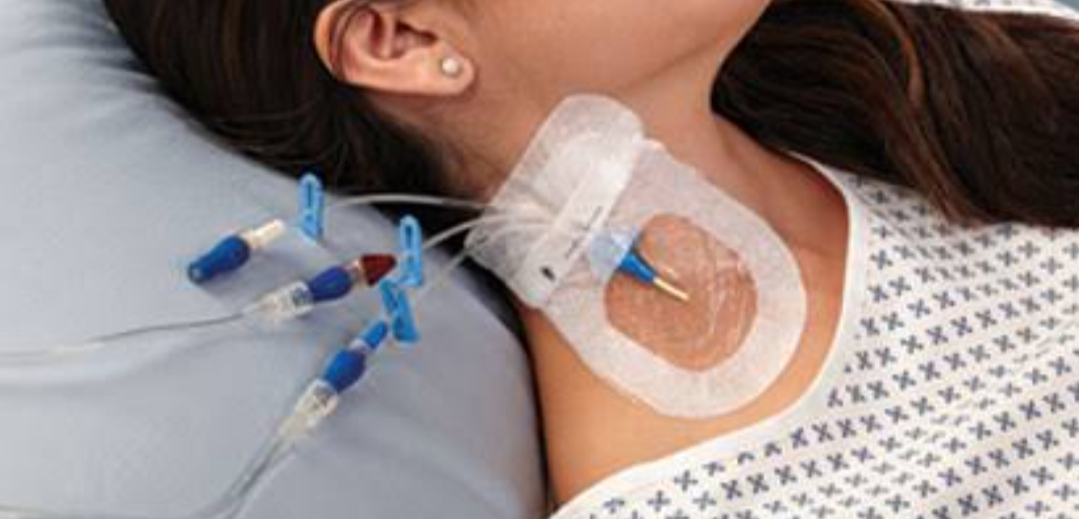Central Line Care
A central line is an IV (intravenous) line that goes into a large blood vessel near the center of the body.
- Central lines are used for giving medications, fluids, IV nutrition and drawing blood.
- The central line is usually placed in the neck,chest area etc. Part of the line goes under the skin and enters a blood vessel several inches away. This type of line is called a tunneled central line.
- The tunneled central line has a cuff under the skin near the exit site. The cuff is a small felt-like piece of material that circles the line. Skin will grow around the cuff to help hold the line in place. The cuff also acts like a barrier to decrease the chance of infection.
- The central line may have a single or double lumen. A single lumen central line has one opening or tube. A double lumen line has two separate tubes within one tubing.
Caring for center line at Home :-
A home care infusion company will give you the supplies needed to care for the central line at home.
- The central line is flushed daily to keep it from clotting. You are taught how to do this by a nurse from your home care infusion company.
- Change the dressing and cap weekly. Also change the dressing if it comes loose and is no longer covering the exit site. A nurse will do this until you are trained to do so.
- There may be some some bleeding after surgery and a dressing change may need to be done sooner than one week.
- Keep the central line safe by using the securing device supplied by the home care infusion company and avoid tugs or pulls on the line.
- Anyone else caring for your child, such as babysitters and teachers, will need to learn central line safety and emergency care.
Safety guidelines for Center line care :-
- Keep the central line dry. Protect the line during bathing. You can cover it with saran wrap or a plastic bag to keep water from getting to the central line.
- Avoid pulls or tugs on the central line and use the securing device to keep the line in place. Loved one should wear a one piece undergarment to protect the line.
- Your loved one need to avoid any activities that could cause damage to the central line, including contact sports.
- Arrangements can be made for a nurse to visit the Home to assist with return to hospital.
- Keep an emergency kit with your loved one at all times. The emergency kit should have tape, a clamp, gloves and gauze and you will be taught how to use the items in the kit should an emergency occur.
Possible problem with a center line :-
- Infection
- Blocked or clotted line
- Central line dislodged
- Hole or tear in central line
- Air in bloodstream
Sign of a problem :-
A skin infection at the central line site is possible if there is:-
- Redness
- Drainage
- Pain
- Swelling
- Warmth
A bloodstream infection is possible if your child has:
- Fever
- Chills
- Sweating
- Drowsiness or dizziness
- A sick feeling
Blood can clot inside the tubing and cause a blocked or clotted central line. You would know there is a blockage if:
- The central line becomes very hard to flush or you cannot flush it at all
- An IV solution will not go in through the central line
- A pull or tug on the central line could dislodge the line. It could also cause damage to the central line.
It is possible to get a hole or tear in the central line. You may be able to see the hole or tear. There could also be damage that you cannot see. Signs of damage:
- Wetness under the central line dressing or along the tubing
- An area of bulging on the central line
- A pink area on the central line that does not clear with flushing
- Puffiness or swelling on the skin near the central line
Air in the bloodstream is very rare. But it could happen if the cap came off the end of a central line that is not clamped. It could also happen if there was a cut or tear in the central line. It takes a large amount of air in the bloodstream to cause a problem. If air gets into the bloodstream, your child could have:
- Trouble breathing
- Chest pain
- Coughing
If there is a problem with centerline :-
Call the doctor or nurse if your lovedone has:
- A fever
- Chills, sweating, drowsiness and feels sick
- Trouble breathing or chest pain
- Any redness, swelling, pain or drainage around the central line
- Feeling that something isn’t right in the chest area
- Bulging area on central line or wetness under dressing
Preventing a problem with a Center line :-
- Wash your hands before doing any central line care and wear gloves.
- Always keep a clean and dry dressing over the central line site.
- Follow the instructions for cleaning the cap and using sterile equipment.
- Avoid tugs or pulls on the central line. Take extra care when removing clothing to avoid a pull or tug.
- Secure the central line to your child’s body with the clips. For younger children, use one-piece outfits to cover the central line.
- Always keep scissors and all sharp objects away from the central line.
- If the central line is hard to flush, do not try to force it.






Comments
Post a Comment